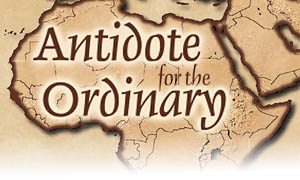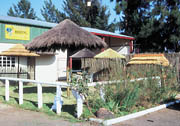
Over the course of time, we have been invited to tour many facilities engaged in the manufacture of roofing materials, including shingles, felt, MB, single-ply, and insulation, just to name a few. Each plant features machines that mass produce products utilizing computerized technology. This reduces labor and results in a product that is high in quality shift after shift. A recent visit to Africa Roofing, a thatch roofing manufacturer and installer, provided an experience that was unique among all the others.
The Company
Africa Roofing was founded in 1994 by managing director Jan Grobler. After informally trading for five years, the first company, Redruth Thatching, officially began in 1979. After several acquisitions, Grobler now manages a group of companies that manufacture and install thatch roofing and other construction products in South Africa. Working with a group of agents in several countries, Africa Roofing is the export division of this growing business with the goal of establishing a worldwide agency network to export the thatch roofing and construction products manufactured in its Alberton, South Africa (near Johannesburg), facility.Grobler’s management team includes Andre Bronkhorst and Chemist Kula. Bronkhorst is the exports director and deals with all aspects of exports for the firm. He has been in the thatching field for 15 years. To his credit are a number of computer programs used for the calculation and surveying of thatch roofing projects. Kula, with his 21 years of experience in the thatching field, is considered the company’s expert on thatched-roof structures and customized thatching. He has been instrumental in the development of a number of the firm’s do-it-yourself (DIY) products.
Africa Roofing manufactures or markets several products, including treated Eucalyptus poles, DIY thatch tiles, rustic fencing, beach thatch umbrellas and kiosks, modular thatched gazebos and bungalows, and a synthetic thatch product called FiberThatch. In addition to this, Africa Roofing sells ropes and blinds made from natural materials as well as fire retardant and preservative materials.

Thatch Roofing Products
Thatch roofing is truly one of the most rare of all roof-cladding products in the United States. In Africa, of course, it is considerably more common. Even in Africa, however, thatch roofing is considered something of a specialty roofing product. Africa Roofing engages thatch roofing on a number of different levels. Its product line does include custom thatch roofing, but it also includes the other building products that go into the construction of thatch-roofed structures.There are numerous types of thatching grass native to South Africa, and a number of systems employed in the construction of thatch-roofed projects. In South Africa, “A Guide to Good Thatching Practice,” is published by the Division of Building and Construction Technology. This comprehensive guide gives a practical look at the various grasses used, the strengths and weaknesses of thatch roofing systems, a guide to tools and application, design criteria, guidelines for a typical thatch roof specification, and fire safety design guidelines.
Africa Roofing refers to its several thatch roofing products as either “custom” or “DIY.” Typically, custom thatch roofing is exported with labor included, and is the type of thatch roofing found on homes and buildings in Africa. Custom thatch roofing in South Africa typically comes with a three-year labor and materials warranty. Even though the roof is expected to last 20, 30 or even 40 years, consumers expect that if the roof lasts three, it will last 20. Maintenance is required and expected (more on that later).
Custom thatch roofing in South Africa blends locally available materials with a look that is centuries-old traditional. It blends well with the landscape and has the ecological advantage of being produced by an energy-efficient, natural process. A custom thatch roof functions as a ceiling as well as an insulated roof covering. The ceiling is formed by the installation of selected reed, Cape reed, or cleaned thatching stems installed prior to the thatching. This is known as the “spray” layer. Thatch roofing is, however, vulnerable to fire, susceptible to decay and decomposition, and can harbor vermin. Use of fire retardant materials, proper installation techniques and maintenance improve performance, fire resistance and longevity.

Manufacturing Processes
The manufacturing process for the custom thatch involves a rather simple process of receiving, grading and storing bundles of thatching grass supplied by independent contractors who cut and wrap the thatching grasses that grow wild all over South Africa. This is an oversimplification, as there are many varieties of grasses used which, like all roofing materials, look and perform differently in use as a part of a roofing system.The DIY line of products forms the basis for Africa Roofing’s export business. The manufacturing process for the DIY line of products is somewhat more sophisticated, and involves a production line to manufacture panels of thatch used to make gazebos, umbrellas, kiosks and other “outside” structures. The DIY products are not, like custom thatch roofing, entirely waterproof. They are designed mostly to provide shade and a modest amount of protection from the elements. These panels are, however, inexpensive, and easy to install on a custom-built structure, or any one of a number of “kit” or “modular” structures that Africa Roofing manufactures at the same facility.
Reacting to a demand for a DIY product that will be long-lasting and maintain its original blond color, Africa Roofing has developed a synthetic thatch product that is manufactured into panels in a similar process to the natural DIY panels. Using a blond-colored polyolefin “stem,” the panels are visibly more uniform than the natural thatch product, but provide a surprisingly realistic finished product called “FiberThatch.”
Maintenance and Upkeep
Like any roof, you must maintain thatch roofing to achieve a maximum life expectancy. According to the “Guide to Good Thatching Practice,” there are several key elements to good thatch-roof maintenance, several of which involve the design phase. To begin with, the thatch roof must have a minimum of a 45-degree pitch to achieve proper watershed. Less than this will allow for premature decay of the grasses. In the installation process, it is necessary to use only properly “ripened” grass. The harvesting season for thatching grass depends on the variety and location, but typically ranges between March and August (fall/winter). It is essential to keep the thatch roof free of other organic debris, such as leaves from surrounding trees. While on a side trip to Kruger National Park, we also discovered that baboons like to sleep on thatch roofs, but only after they tear out a good section as a temporary nest. Good thatch-roof maintenance includes measures to keep the baboons off your roof.
The key maintenance activity after the roof is in service is “brushing” with a thatching spade called a leggatt. The leggatt is also used in the original installation to smooth and shape the thatch as it is installed. The brushing is done from the bottom up, and effectively shaves a layer of decayed thatch off, revealing fresh grass and tightening up the entire system.
The Tradespeople
The labor force at the manufacturing facility was substantial, and included many women. Typically, the workers who go to the jobsite to install the thatch are men trained by their fathers, who in turn were most likely trained by their fathers in the craft. The wages of the plant workers are meager by our standards, roughly the same pay per day that our teenagers are paid per hour working in a fast-food restaurant. Installers are paid double that wage, and all qualify for production bonuses.Workers comp costs 2 percent of a workers salary, 1 percent borne by the employer, and 1 percent by the employee. In South Africa, employers are not responsible for health care. The state provides health care free, but paid hospitals are available to those who can afford it. On the other hand, businesses with sales in excess of R600,000 (around $50,000 US) are required to pay a “value-added” tax of 14 percent. This is charged inclusive based on the sales price of the job.
Getting help is not the number one issue for employers in South Africa. Extremely high unemployment rates, along with a large percentage of the working population testing positive for HIV, represent more pressing problems. Africa Roofing’s recent plant expansion allowed for the hiring of 15 additional workers. When the word got out, the plant had to choose from the 300 or so individuals who showed up to apply for a week straight. Many of the would-be plant workers walked miles for the opportunity to stand in line for a shot at one of these prized positions. Grobler, moved by the showing, hired an additional five of them.
Africa Roofing exports its labor on custom thatch-roofing jobs. Grobler tells us that when the workers return from assignments in the United States, they “come back fat.” They are unaccustomed to the large portions we have over here. Many jobs are substantial and because of the time limitations of work visas, it is necessary to send several crews. The typical thatch roofing crew is at least four men, with one transporting bundles of thatch to the roof, two working on the roof, and one working beneath them inside. The work is so specialized and laborious, it is better done by these skilled installers, even with the relatively high cost of travel and remote accommodations.
South Africa: A Nation of Contrasts
Doing business in South Africa, like anywhere, is flavored by its people and political systems and cultures. Black, white, tan and brown all have a distinct meaning in this nation of contrasts. The operations of Africa Roofing are on the one hand relatively high technology. They employ sophisticated computer and communications systems to process their business. The DIY panel production plant uses modern production-line techniques. The Web site (www.thatchroofs.com) is every bit as useful as the sites of some major roofing manufacturers.On the other hand, the company’s workers are largely undereducated and have limited prospects. With the end of apartheid, however, new opportunities emerge for all the people of South Africa. The end of that era has opened the doors for entrepreneurs like Jan Grobler to do business all over a previously unfriendly world.
Africa Roofing’s DIY product can be found at a number of coastal resorts worldwide, and their custom thatch work can be found in the United States at the zoo in Louisville, Ky., the LaCovacha Restaurant, and numerous other buildings and private residences across the globe. So if you have a client interested in constructing in a true African motif, you now have a point of contact with an authentic source.



